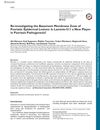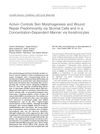Laminin-511 Is a New Player in the Development of Psoriasis and Controlled via Cannabinoid Receptor Type 1
TLDR Laminin-511 is involved in psoriasis development and can be regulated by cannabinoid receptor type 1.
The study investigated the role of basement membrane (BM) components, particularly laminin-511, in the development of psoriasis using an imiquimod mouse model. It was found that BM components, including laminin-511, were upregulated in psoriasis. Laminin-511 was shown to increase keratinocyte proliferation and inhibit apoptosis in HaCaT cells. Knockdown of the laminin α5 gene decreased proliferation and increased apoptosis. The study also explored the role of cannabinoid receptor type 1 (CB1) in regulating laminin-511 expression. CB1 agonist (ACEA) decreased laminin α5 expression, while antagonist (AM251) increased it. Injection of ACEA into the psoriasis model mice partially reduced epidermal thickening and keratinocyte proliferation. The findings suggested that CB1 and laminin-511 could be potential targets for psoriasis treatment.


